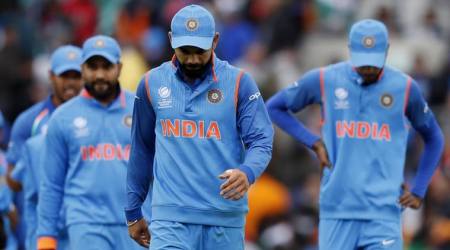
via Imago
Indian Cricket team

via Imago
Indian Cricket team
India’s second match in the Champions Trophy was disheartening for the billions of fans back home. A win in the match would have secured India’s position in the semis. But the Lankans came out mightier in the match defeating India by 7 wickets. With this victory, they equaled their record for the highest ODI run-chase. The bowling attack which wrapped up the Pakistan innings at 164, bowled out Bangladesh and New Zealand in the practice matches before 40 overs could not defend a total above 300.
With 321 runs on the board, the Indian team would have been eyeing the semis spot after the first innings. But the Lankans had other ideas. What went wrong for India after such a strong batting display? Was the total not enough to defend at the Oval or the bowling not up to the mark? Let’s find out:
Failure in breaking partnerships
ADVERTISEMENT
Article continues below this ad
Without a doubt, it could be said that the Indian bowling against Sri Lanka was not looking as sharp as compared to what we saw against Pakistan. Bhuvneshwar Kumar was the only Indian bowler who succeeded in taking a wicket as both the other wickets came through runouts. India’s most successful bowler against Pakistan, Umesh Yadav bowled with an economy close to 7. This was not acceptable after he set the expectations high.
Moreover, it was the partnership between Gunathilaka and Mendis which got the Lankans set on their way to victory. They held their nerves on crucial occasions and built a 150+ partnership with a run-rate of 6.9. Having played less than 20 ODIs before this match, Gunathilaka was fairly inexperienced in front of the Indian pace attack. After the early breakthrough of Dickwella, the Indian seamers should have kept their bowling tighter and not allowed the youngster to set on the crease.

Even after Gunathilaka and Mendis fell, the Indian attack was again not able to break the budding partnership between Perera and Mathews, who playing his first match in months. And the final showdown by Gunaratne saw Sri Lanka sail through which the Indian pacers had no answer to.
Sri Lanka’s shot selection
As mentioned earlier, Sri Lankan batting was something that thoroughly deserved some praise. The second wicket partnership between Gunathilaka and Mendis was more than demoralizing for the Indian bowlers. Gunathilaka played the quick innings whereas Mendis supported him strongly with singles and doubles.
Gunathilaka scored 76 off 72 with 7 fours and 2 sixes. In an ODI facing the in-form Indians, such heroic innings marked his entrance to the international circuit. He put u a great mix of cheeky shots along with textbook placements to see through the Indian bowling. Mendis remained in no way short. They both put together a performance to remember as the Indian attack found no ways of penetrating their stance.

via Imago
Credits: sports247.com
Towards the end Gunaratne and Mathews requiring 51 off 42 after Perera’s departure, sailed their way through with some outstanding shots past the Indian fielding.
Not taking advantage of wickets in hand
Dhawan and Sharma became the first Indian pair to put up a hattrick of century partnerships in the ODIs with their 138 runs stand against Sri Lanka. But was this partnership as helpful to India as you might think? As a matter of fact if we compare their run rate with that of Sri Lanka’s second wicket stand, the results are shocking. While Sri Lanka managed to pull a run rate of 7 after the early fall of Dickwella, the Dhawan-Sharma pair played with a run rate below 6.

via Imago
Credits: Espncricinfo
After Kohli’s wicket, the Indian run rate fell from 5.7 to close to 5 until the 40 over even though they were just 3 wickets down. Dhawan and Dhoni unleashed some powerful hitting after that but was it too late by then to pick up the run rate? India scored 80 runs from over 25-40 whereas the Lankans managed to score 103 off the same. Indians could have utilised it better with Dhawan all set in the crease and the in-form Yuvraj just arrived and with Jadhav, Dhoni, and Pandya yet to come.
Felt the absence of Ashwin
Ashwin carries a brilliant record against left-handers and the Sri Lankan team consisted of three left-handers including the pair of Gunathilaka and Mendis. His presence could have made the difference to take India to the semis. He holds an average of 27 against the Lankans as opposed to 32 against others. His economy is also lower than usual against them. His absence in the team might have been Kohli’s biggest blunder ahead of the match.
India played just one full-time spinner Jadeja who went for over 8.5 runs per over in his 6 overs. With Jadeja failing, India was in a shortage of bowling options in the middle overs as Kohli himself bowled 3 overs and went for 17 runs. Jadhav too chipped in a few overs to fill in the deficit. Despite playing 5 bowlers, India was running low in options after 2 of the frontline bowlers failed. Having Ashwin in the lineup could have saved India from this situation.

Took the opponents too lightly
ADVERTISEMENT
Article continues below this ad
Dickwella, the Sri Lankan wicketkeeper in a press conference post-match said, “I have heard that they (India) said that they take this game as a practice game, I don’t know, and this is a return. It hurts sometimes for us as both the teams play at the same level and they think this is a practice game and we got the revenge.”
India’s narcissism over their last dictating win against Pakistan could have turned against them this time. They took the young Sri Lankan side far too lightly and misjudged their potential by a big margin. The Indian side though well balanced between young and experienced players made the mistake of undermining their opponents.
ADVERTISEMENT
Article continues below this ad


